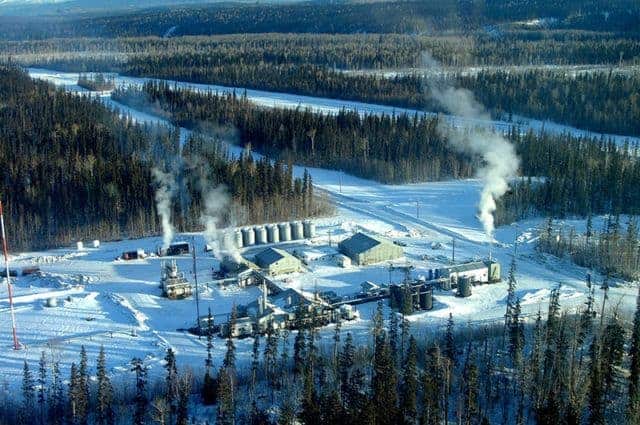
After becoming aware of my interest in sasquatch, a friend shared his sasquatch encounter. The sighting occurred in early October of 1989 at the Kotaneelee Natural Gas Plant. This natural-gas area was discovered in 1977, the plant came into operation in 1979, ceased operation in 2012 and remediation work started in 2018. He shared his experience in 2005.
The Kotaneelee Camp is located some 270 kilometres east of Watson Lake, in the Yukon’s Liard Plateau, close to Coal River Springs Territorial Park. Part of the gas-field area is located in southeast Yukon, part of it in the southwestern part of the Northwest Territories, and part of it in northern British Columbia.
My friend had been working at the site for a couple of years on a two-week rotational basis. After dinner at the camp dining hall, one October evening at around 9 p.m., he went out for a walk in the nearby woods with a co-worker and friend from the Liard First Nation, as they had usually done ever since working there.
Some 300 metres from their bunkhouse, they came to a small clearing. It was a clear evening and the moon was out; not a cloud in the sky and no wind, although it was a bit cold.
As they approached the clearing, they observed a tall, skinny bipedal creature of sorts that was dancing in the full moonlight—waving its arms about and jumping up and down in a comical sort of way—seemingly enjoying himself, as my friend told me. The creature, which was identified as a sasquatch, was about 2.5 metres tall, according to my friend, and had whitish-coloured hair with what he determined were bare patches of missing hair, here and there, and it seemed emaciated.
They watched the dancer, without moving, for about two minutes, but then, as they tried to get closer, wanting to see better, the creature noticed them and walked swiftly into the nearby forest without making a sound. As it had snowed recently, they figured they could pick up some tracks or footprints, so they ventured closer to where the dancer had been, but there were no tracks. No footprints could be found, which they thought was very odd.
They never mentioned their encounter to anyone, as the witness told me. They were scared to be labelled fools and be ridiculed by their workmates and others (a very natural reaction from the majority of people who are unaware of sasquatch).
A few things come to mind regarding this: in that region of the Yukon, there are numerous, small hot springs—none of which are accessible by road.
A bit farther south into British Columbia, in the direction of the Liard River, is the well-known Liard River Hot Springs, which is easily accessible from the Alaska Highway, by the Liard River Bridge, and is used year-round by highway travellers.
Due to the hot spring’s warm water, plants have a tendency to be more numerous, grow much larger (actually, one finds plants not found elsewhere) and provide a larger variety of food readily available for the taking, as well as providing a good source of food for various animals.
I was able to arrive at the following dimensions concerning our dancer. By using an approximate height of 2.5 metres, as stated by the witness, I calculated that the creature would have had a footprint of about 40.6 centimetres, with a step (the distance between the toes of one foot to the toes of the following foot) of about 156 centimetres. Its weight would have been hard to judge, as it was noted that the subject was skinny, “emaciated,” probably due to aging, and would have been around 150 kilograms.
Another interesting point is that sasquatch age and get old, much like us humans do.
This encounter took place in 1989 and was relayed to me in 2005. I had to investigate a few occurrence sites in the region, in 2007, and made an attempt to enter the access road off of the Alaska Highway, in B.C., but I could not, as the access road had a manned guard gate and was restricted to employees and contractors who presented proper identification.
By the time the remediation work started, in 2018, all of the equipment had been removed, and the road was no longer usable by 2020. So I never did visit the sighting location, unfortunately.




